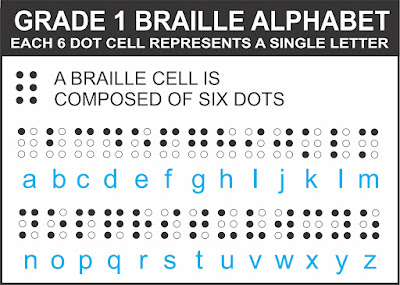What
is Grade 2 Braille?
Braille
is a tactile writing system of letters, numbers and characters using
raised braille cells or raised dots. It allows the sight impaired or
blind to read and write. Invented by Louis Braille in 1824, this
system is worldwide and required on all signage marking permanent
rooms and spaces in the United States, as specified by the Americans with Disabilities Act, (ADA). Specifically, ADA requires Grade 2
Braille on all ADA braille signs.
So
what’s the difference between Grade 1 and Grade 2 braille? Grade 1
braille, or sometimes called “uncontracted braille” is where each
letter of the alphabet is represented by one individual braille cell
or symbol. A braille cell is composed of six dots, and each letter is
composed of its own unique variation of these six dots, (see diagram
A). So if a word has 7 letters, it will also have seven braille cell
characters or symbols in Grade 1. This is the most basic type of
braille.
Grade
2 braille can be considered a “short hand” version of Grade 1.
Grade 2 braille sticks with the same numbers, punctuation and letter
symbols as Grade 1 but uses contractions to represent common words
and groups of letters. For example the letters “ing” can be found
in many words, (working, biking, playing, etc.) Grade 1 braille
would use three separate cells or symbols to represent “ing”
however Grade 2 would only use one 6 dot cell or symbol represent
“ing.” See diagram B showing the difference between Grade 1 &
2 Braille for the word “women” Here you can see the “en” is
contracted in Grade 2.
As
you might guess, Grade 2 braille is used by more experienced braille
readers and has its advantages. Grade 2 braille is more efficient,
can be read faster and takes up less space. This is why it’s the
preferred and required braille format for most braille you see in
public spaces, including ADA braille signs, ATM's, control panels, elevator signage, etc.

